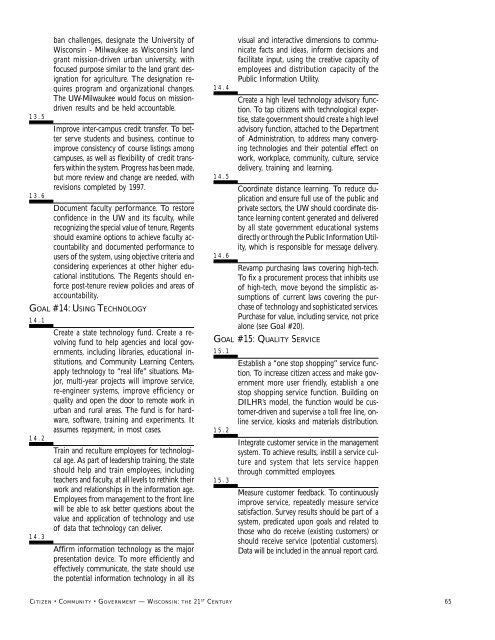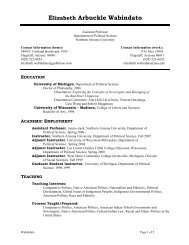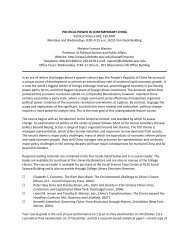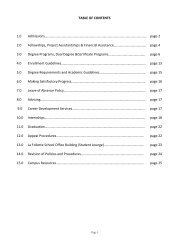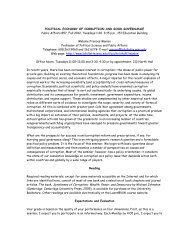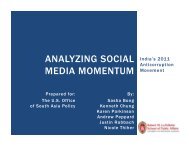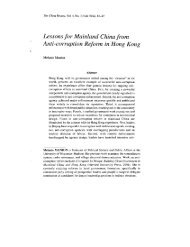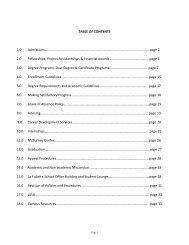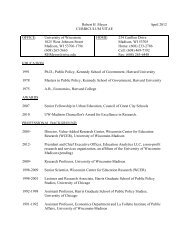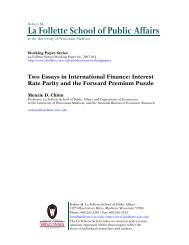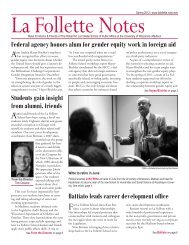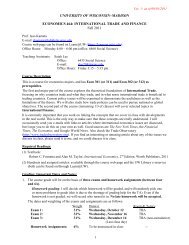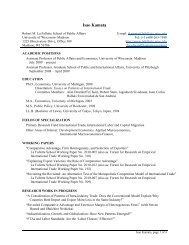SAVE Commission's findings - La Follette School of Public Affairs ...
SAVE Commission's findings - La Follette School of Public Affairs ...
SAVE Commission's findings - La Follette School of Public Affairs ...
Create successful ePaper yourself
Turn your PDF publications into a flip-book with our unique Google optimized e-Paper software.
13.5<br />
13.6<br />
ban challenges, designate the University <strong>of</strong><br />
Wisconsin - Milwaukee as Wisconsin’s land<br />
grant mission-driven urban university, with<br />
focused purpose similar to the land grant designation<br />
for agriculture. The designation requires<br />
program and organizational changes.<br />
The UW-Milwaukee would focus on missiondriven<br />
results and be held accountable.<br />
Improve inter-campus credit transfer. To better<br />
serve students and business, continue to<br />
improve consistency <strong>of</strong> course listings among<br />
campuses, as well as flexibility <strong>of</strong> credit transfers<br />
within the system. Progress has been made,<br />
but more review and change are needed, with<br />
revisions completed by 1997.<br />
Document faculty performance. To restore<br />
confidence in the UW and its faculty, while<br />
recognizing the special value <strong>of</strong> tenure, Regents<br />
should examine options to achieve faculty accountability<br />
and documented performance to<br />
users <strong>of</strong> the system, using objective criteria and<br />
considering experiences at other higher educational<br />
institutions. The Regents should enforce<br />
post-tenure review policies and areas <strong>of</strong><br />
accountability.<br />
GOAL #14: USING TECHNOLOGY<br />
14.1<br />
Create a state technology fund. Create a revolving<br />
fund to help agencies and local governments,<br />
including libraries, educational institutions,<br />
and Community Learning Centers,<br />
apply technology to “real life” situations. Major,<br />
multi-year projects will improve service,<br />
re-engineer systems, improve efficiency or<br />
quality and open the door to remote work in<br />
urban and rural areas. The fund is for hardware,<br />
s<strong>of</strong>tware, training and experiments. It<br />
assumes repayment, in most cases.<br />
14.2<br />
Train and reculture employees for technological<br />
age. As part <strong>of</strong> leadership training, the state<br />
should help and train employees, including<br />
teachers and faculty, at all levels to rethink their<br />
work and relationships in the information age.<br />
Employees from management to the front line<br />
will be able to ask better questions about the<br />
value and application <strong>of</strong> technology and use<br />
<strong>of</strong> data that technology can deliver.<br />
14.3<br />
Affirm information technology as the major<br />
presentation device. To more efficiently and<br />
effectively communicate, the state should use<br />
the potential information technology in all its<br />
14.4<br />
14.5<br />
14.6<br />
visual and interactive dimensions to communicate<br />
facts and ideas, inform decisions and<br />
facilitate input, using the creative capacity <strong>of</strong><br />
employees and distribution capacity <strong>of</strong> the<br />
<strong>Public</strong> Information Utility.<br />
Create a high level technology advisory function.<br />
To tap citizens with technological expertise,<br />
state government should create a high level<br />
advisory function, attached to the Department<br />
<strong>of</strong> Administration, to address many converging<br />
technologies and their potential effect on<br />
work, workplace, community, culture, service<br />
delivery, training and learning.<br />
Coordinate distance learning. To reduce duplication<br />
and ensure full use <strong>of</strong> the public and<br />
private sectors, the UW should coordinate distance<br />
learning content generated and delivered<br />
by all state government educational systems<br />
directly or through the <strong>Public</strong> Information Utility,<br />
which is responsible for message delivery.<br />
Revamp purchasing laws covering high-tech.<br />
To fix a procurement process that inhibits use<br />
<strong>of</strong> high-tech, move beyond the simplistic assumptions<br />
<strong>of</strong> current laws covering the purchase<br />
<strong>of</strong> technology and sophisticated services.<br />
Purchase for value, including service, not price<br />
alone (see Goal #20).<br />
GOAL #15: QUALITY SERVICE<br />
15.1<br />
Establish a “one stop shopping” service function.<br />
To increase citizen access and make government<br />
more user friendly, establish a one<br />
stop shopping service function. Building on<br />
DILHR’s model, the function would be customer-driven<br />
and supervise a toll free line, online<br />
service, kiosks and materials distribution.<br />
15.2<br />
Integrate customer service in the management<br />
system. To achieve results, instill a service culture<br />
and system that lets service happen<br />
through committed employees.<br />
15.3<br />
Measure customer feedback. To continuously<br />
improve service, repeatedly measure service<br />
satisfaction. Survey results should be part <strong>of</strong> a<br />
system, predicated upon goals and related to<br />
those who do receive (existing customers) or<br />
should receive service (potential customers).<br />
Data will be included in the annual report card.<br />
CITIZEN • COMMUNITY • GOVERNMENT — WISCONSIN: THE 21 ST CENTURY 65


